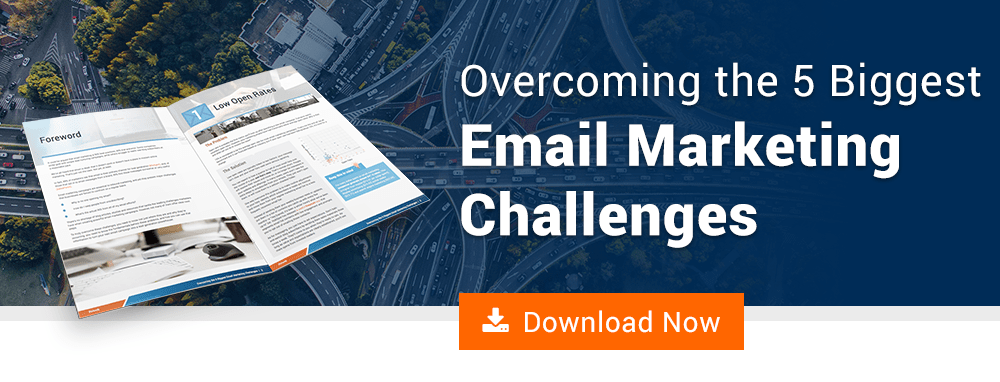Email marketing can be daunting. You put so much time and effort into crafting the perfect email, yet the email(s) don’t perform how you would want them to – or, frankly, you may be unsure how to even measure success.It can be overwhelming to think through how to optimize your emails – especially if you are a one man/woman show within your company with numerous other responsibilities.
Recently, we were helping a client optimize their email marketing strategy, and we wanted to share some key tips that you should keep in mind for your next email send or crafting your overall email marketing strategy.
1. Determine Your Goal

Understanding your goal is crucial to your email marketing strategy, as is defining a goal for each email that you send.
Many people will say that their goal is to “spread awareness,” but how do you measure awareness? If your email is just filled with copy but contains no conversion points, is the open rate considered your metric for success?
Give your readers a secondary action to take. Do you want them to follow you on your social networks? Do you want them to go to your website and browse after reading your email? Do you want them to go to a specific landing page to convert on a form?
You can break your email strategy down into various campaigns with different themes and different goals.
From there, measure how your various campaigns are performing and understand what is working well and what isn’t with the goals you’ve created.
2. Keep Your Emails Concise
Emails are meant to be treated as notification purposes and not an extension of your website. They should be a quick message, not a tome.
It’s important to understand that you don’t need to provide every single detail about a particular topic/message/theme – you want to capture the critical information that is crucial for someone to know.
Put yourself in their shoes: Do you read the full length of emails that you receive? If your reader viewed your email for 10 seconds, what would the most important information you would want them to know?
3. Focus on the Mobile Experience
Email templates can be complicated to figure out unless you are an expert developer that specializes in building emails.
It’s important to understand that when you send an email, that email is viewed via a number of different email clients (i.e. Outlook, Gmail, Apple mail, Yahoo, etc.).
Email clients don’t behave in the same way and interpret emails on varying degrees. Your email could look great on one email client and appear broken in another.
Additionally, emails viewed on the web may appear different than they do on mobile. This is significant because emails are increasingly being viewed on mobile.

Having a responsive email template will help to optimize your email for any view. The good news is a lot of email marketing tools provide responsive templates for you to use. However, there are still some templates that are not responsive.
But, how do you know whether it is a responsive template? A good way to check is to:
- View your email on mobile and see how it looks. Are the images disproportionate? Is there weird spacing? Are inconsistent colors/fonts displaying?
- Test your email by sending to a few different email clients.
- Open your email in a web view and adjust the sizing of your webpage to make it smaller and larger.
- When you dragged the browser in, did your email auto adjust to be optimized for the view? Or, did the copy get cut off so that you can only see the left half of your email? This is a good indicator of whether your email template is responsive (mobile friendly) or not.
The length of your emails is also very important to keep in mind for mobile view. It’s difficult to capture your reader’s attention when they are viewing your email on mobile. Additionally, some email clients will cut lengthy copy off in the reader’s mobile view.
4. Pay Attention to the Appearance of Your Email
Ensure your email is visually appealing. If someone has five seconds to scan your email for importance/purpose, where would do you want their eyes to go?
I like to try to use the pyramid format when possible. The pyramid format starts with a header, then follows with an image, copy (say a couple paragraphs, and a call to action (CTA) directing your readers to wherever you want them to go.
You’ll want to keep in mind the following when designing your email:
-
Font Colors: Avoid light colors. These will be difficult to see. Are you using colors that align with your brand? Use bolder colors for CTAs, links, headers. and important text within the copy.
-
Text Size: Make sure your text is readable. User bigger text for headers and CTAs.
-
Break Up Paragraphs: Break up your body copy into digestible chunks of content. Smaller paragraphs are easier to read than a wall of text.
-
Use Bullet Points: Bullet points are a nice visual add. You can use these to highlight the important benefits of your new product/feature/services.
-
Bolding vs. Unbolding: A few examples of content that you can use a bold font for include headers, CTAs, links, important data points, and key dates.
-
Calls to Action: CTAs are very important. These allow your readers to take a secondary action and create conversion points. In addition, CTAs are usually what your readers will see in the first few seconds of scanning your email.
-
Use of Images/Logos: Images and logos are a great addition to your email because the human brain processes images and other visual content faster than text. You can make them clickable, so they become another way to engage a reader. Adding logos can also help to easily connect your email with your brand.
5. Optimize for Open Rates and Click-Through Rate
Optimizing for Open Rate

Open rate is a funny thing. You will never truly be able to measure open rate as certain email clients do not report that an email has been opened.
An open rate doesn’t account for anyone that viewed a text-based email (with images turned off). So, I’d recommend against measuring this as your primary goal.
However, you can optimize for open rates mainly through following subject line best practices as well as making sure you are sending to the right contacts. Remember, open rate is very important in the sense that it brings your reader one step closer to conversion and engaging in your company.
Follow These Subject Line Best Practices.
For the best subject lines guaranteed to have high open rates, we’ve outlined some subject line best practices.
- Keep it short and sweet.
-
Use a familiar sender name; avoid the ‘no-reply’ sender name.
-
Use personalization tokens when appropriate.
-
Tell them what to expect inside; use concise language.
-
Start with action-oriented verbs.
-
Create a sense of importance, but don’t use all caps or overuse exclamation points.
-
Use numbers (when appropriate).
-
Pose a compelling question.
- Don’t forget to A/B test subject lines! A/B testing is very important for your email performance. Marketing is all about trial and error, and A/B testing will allow you to understand what your readers like and don’t like.
Properly Segment Your Email Lists.
Knowing who you are sending to is very important. Knowing who the email recipients are (using your buyer personas) and crafting content to meet their specific pain points enables you to reach that targeted audience on a personal level.
By segmenting your list, you’re narrowing down the list of people that your emails target, which allows you to create tailored emails that are more likely to receive engagement.
Also, make sure your readers want to receive communication from you. Buying your email list, or adding prospects to your database that haven’t given you permission to send them emails does not follow best practices.
In addition, do you have contacts that haven’t engaged with you in a while? Consider removing them from your email list and creating a separate re-engagement campaign to target them.
If you constantly send to contacts that don’t engage with your emails, this will hurt your email domain authority and could be considered spam.
Optimizing for Click-Through Rate (CTR)

CTR is a good metric for helping you understand how your emails are performing. This is because it shows you what people are actually doing with your emails — they are taking an action.
Earlier in my post, I touched on the following questions:
- Do you want them to follow you or engage with your company on your social networks?
- Do you want them to go to your website and browse after reading your email?
- Do you want them to go to a specific landing page and convert on a form?
It is best practice to use CTAs when appropriate. You are doing yourself a disservice if you are not giving your readers a secondary action to take from your email. If they opened your email, they are engaged to a certain extent. Do with what you can with them while you have their attention.
As you can see, there are many components that go into crafting the “perfect email.”
Even then, a perfect email will not always perform how we want them to. You will continually need to optimize your emails because behaviors are constantly changing.
However, having a good email structure and email marketing strategy as a whole will be instrumental to your overall marketing strategy. I hope the above email tips are helpful and are some easy things that you can do to optimize performance in your next email send!


Kristin Jordan
I joined Bluleadz in 2018 as an Inbound Marketing Consultant. A native from New Hampshire, I now reside in the Tampa Bay area after graduating from the University of South Florida in 2013. On my free time, I love doing outdoor activities and hanging out with my two dogs and two cats.